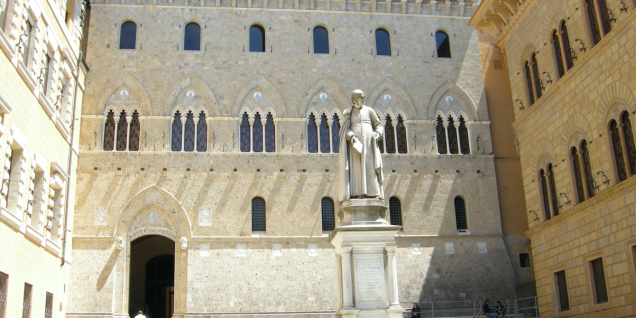(photo: the headquarters of Monte dei Paschi di Siena, the oldest bank in the world)
– by Andrew Spannaus –
Italian banks have been under the spotlight in recent months, considered as a potential source of serious risk for European financial markets and beyond. The danger comes from the level of non-performing loans (NPLs) they hold – 330 billion euros in total ($368 billion) – which could lead to the erosion of their capital and a crisis in confidence, spreading contagion throughout the financial system.
Since the results of the most recent stress tests conducted by the European Central Bank (ECB) were published at the end of July, fears of an immediate crisis seem to have somewhat subsided, but the problem of bad debt remains.
The attempts to clean up the balance sheets of Italian banks have so far been insufficient. The most notable measures in recent months have been the creation of the Atlante (Atlantis) fund, an entity encouraged by the government but market-based with most shares held by Italy’s largest banks, and the international consortium brought together to assist Monte dei Paschi di Siena in increasing its capital and unloading its NPLs.
Italy is also seeing a gradual expansion of bilateral transactions for the purchase of NPLs by smaller banks and funds, that then seek to recover a portion of the capital. An “NPL Summit” was held in Venice on September 16 to gather key players in the sector and discuss measures to facilitate transactions between sellers and buyers.
Before considering the future though, it is necessary to understand how this situation came about. Italy is the No. 2 manufacturing economy in Europe (after Germany), and is a leader in global exports in many industrial sectors, from the better-known areas of food and fashion, to the less visible but essential fields of machinery, mechanical components, and specialty construction (helicopters, yachts, amusement park rides, and more). However, the number of large corporations is limited, which represents a disadvantage with respect to countries such as Germany and France. The economy is characterized by a very high number of flexible, family-owned SMEs.
After the global financial crash of 2008-2009, the economy recovered relatively quickly, as Italians had already been burned by the various stock market bubbles of the 1990s, and thus had avoided getting too involved in risky ventures afterwards. While the majority of Western countries were bailing out their banks with trillions of dollars, Italy stood pat; the goal was to avoid requesting assistance from institutions such as the International Monetary Fund (IMF), and thus to escape any conditionalities that would be imposed from the outside.
It wasn’t long, however, before Italy ended up in the crosshairs of the international financial markets. In 2011 global speculators viewed the country as similar to its weaker Southern European neighbors such as Greece and Spain due to its large public debt. Under pressure from the markets and European political leaders, Italy installed a technocratic government and embarked on a massive austerity campaign, which led to a drop of more than 20% in industrial production. While companies that exported large amounts of their products were able to weather the storm, the internal market was crushed. Tens of thousands of SMEs went bankrupt, while countless others struggled to make it through the crisis.
After three years of negative GDP, the economy began to recover in 2015, but very slowly. The initial hopes for a period of sustained growth have been tempered in 2016, with forecasts for this year and next being continually downgraded. As a result, the return to pre-crisis levels is far, far off. The national industrial association Confindustria estimates that it will take until at least 2028 to get back to the level of economic activity reached in 2007.
For banks, the stagnant economy has meant that many companies are unable to honor their debts, and in Italy businesses get most of their funding from banks, whereas the capital markets have a much smaller role than in the United States, for example. Italians are wary of speculative ventures on the financial markets, which makes them wary of non-traditional funding schemes as well.
The end result is that banks find themselves saddled with large amounts of distressed assets, a situation which is unlikely to change anytime soon without outside intervention. One solution could be a public move to create a so-called “bad bank” to get the debt out of the system, but EU regulations prohibit government intervention as it is considered market distortion. Thus attempts continue to come up with market-based solutions, but it is likely these will fail to reach their goal until economic activity rebounds – also unlikely in the short-term without a shift away from the austerity mindset and a return to stimulus for the productive economy.
In the meantime the market for NPLs is becoming more important, with private players aiming to lighten the balance sheets of the large banks. For these banks and funds, the aim is to negotiate a good price on the distressed assets, and turn a profit on their recovery.
Banca IFIS, an independent Italian banking group specializing in trade receivables, non-performing loans, and tax receivables, organized the “International NPL Meeting 2016” in Venice on September 16, the fifth edition of the annual event. Over 500 representatives of investment funds, banks, servicers, and other professionals in the sector participated in a discussion on “How to fill the gap,” i.e. how to get the large banks to lower their asking prices, or make it more convenient for buyers to intervene at current levels.
Participants in the Meeting included important international funds such as Blackstone and Cerberus. The latter is among those that have earned the name of “vulture funds” due to their activities buying up debt at pennies on the dollar in countries such as Argentina, and then seeking court orders for repayment in full.
The Italian situation seems to be at a turning point. While some players in the NPL market do the detailed work of negotiating repayment terms with families and small businesses, others are clearly less worried about the welfare of the economy, but looking to make a quick buck.
Adding to this is the uncertainty regarding government intervention. Many large banks are reluctant to sell off their distressed assets at a large loss, hoping that either a political solution will be devised at some point, or an economic rebound will shift some of the debt into more promising categories. The players in the NPL market who gathered in Venice lament this uncertainty, as it acts as a significant brake on the market. Beyond their own specific interests, the question looms large for Italy and for Europe as a whole: will governments push for stronger intervention to revive the economies of the continent, creating a rising tide that will lift the banks as well, or is it time to bite the bullet and shed the NPLs at the prices offered by investment funds?
The EU institutions are loathe to go against their stated free-market principles, and always act quickly to head off moves by governments that would directly shape the economy. But the weakness of the recovery is creating problems that go far beyond the balance sheets of the banks, leading to political protest movements that threaten the survival of the EU institutions themselves. These pressures are likely to increase even further in the coming months, hastening a decision on how to deal decisively with the legacy of the man-made economic crisis that has afflicted much of Europe for more than five years.







September 19, 2016
English, Notizie